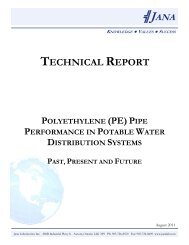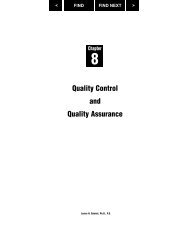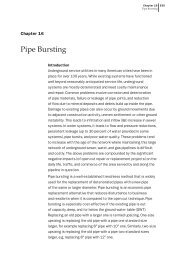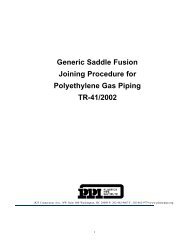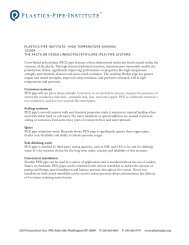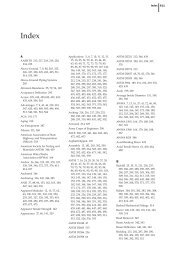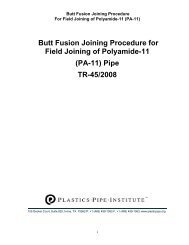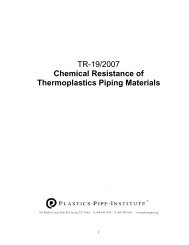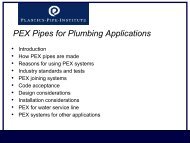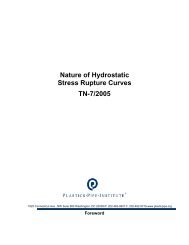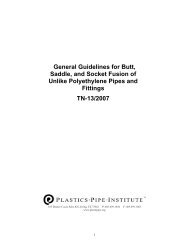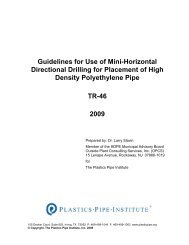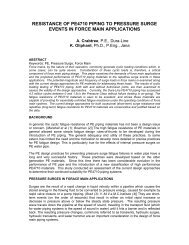TR-34: Disinfection of Newly Constructed Polyethylene Water Mains
TR-34: Disinfection of Newly Constructed Polyethylene Water Mains
TR-34: Disinfection of Newly Constructed Polyethylene Water Mains
Create successful ePaper yourself
Turn your PDF publications into a flip-book with our unique Google optimized e-Paper software.
1. Introduction<br />
Disinfecting <strong>of</strong> water mains has been a common industry practice for many<br />
years. The first AWWA standard covering this practice was approved in<br />
September 1947 (as 7D.2-1948). In 1986, the designation <strong>of</strong> the standard was<br />
changed to AWWAC651; the latest revision is ANSI/ AWWA-C651-92. The<br />
standard describes methods <strong>of</strong> disinfecting newly constructed potable water<br />
mains; mains that have been removed from service for planned repairs or for<br />
maintenance that exposes them to contamination; mains that have undergone<br />
emergency repairs due to physical failure; and mains that, under normal<br />
operation, continue to show the presence <strong>of</strong> coliform organisms.<br />
Because the chlorine disinfection process puts pipe in contact with a strong<br />
oxidizer, a task group was formed in June 1993, within the PPI Technical<br />
Committee to investigate possible effects <strong>of</strong> disinfection on the durability <strong>of</strong> PE<br />
piping in potable water service. While C651 covers all piping materials used in<br />
potable water service, this investigation was confined to polyethylene systems.<br />
Chlorine was the only disinfecting agent investigated; chloramines were not<br />
evaluated. All tests conducted were short term, run at ambient temperature<br />
conditions on pipe samples made from particular polyethylene pipe compounds.<br />
The report is not to be construed as an indicator <strong>of</strong> the long-term performance <strong>of</strong><br />
polyethylene pipe in general, or in the specific user’s environment and operating<br />
conditions.<br />
2. Scope<br />
At the first task group meeting, the following scope was adopted: To investigate<br />
and quantify, if possible, any effects on the durability <strong>of</strong> PE piping caused by<br />
disinfection per AWWA C651. Exposure times and concentration levels were<br />
chosen to be consistent with the requirements <strong>of</strong> the standard. Note that the<br />
disinfection practices outside the constraints used in this study (i.e., exposure<br />
time, etc.) may yield different results - e.g., if a contractor leaves a pipe full <strong>of</strong><br />
concentrated disinfectant for 6 months.<br />
3. Methods <strong>of</strong> Chlorination<br />
Three methods <strong>of</strong> chlorination are explained in AWWA-C651: tablet, continuous<br />
feed, and slug. The tablet method is intended to give an average chlorine dose <strong>of</strong><br />
approximately 25 mg/L, and precautions shall be taken to ensure that air pockets<br />
are eliminated and the water shall remain in the pipe for at least 24 hours. If the<br />
water temperature is less than 41°F (5°C), the water shall remain in the pipe for<br />
at least 48 hours ; the continuous feed to give a 24 hour residual <strong>of</strong> not less than<br />
10 mg/ L; and the slug method to give a 3 hour exposure <strong>of</strong> not less than 50<br />
mg/L free chlorine. .. Residual free chlorine In the slug method, shall be<br />
measured as it moves through the main. If at any time it drops below 50 mg/ L,<br />
the flow shall be stopped, chlorination equipment shall be relocated at the head<br />
4




